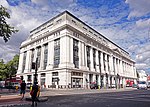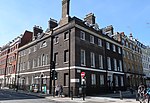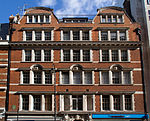Statue of Charles James Fox
Bronze sculptures in the United KingdomBuildings and structures completed in 1814Cultural depictions of British menCultural depictions of politiciansGrade II* listed buildings in the London Borough of Camden ... and 6 more
Grade II* listed statues in LondonMonuments and memorials in LondonOutdoor sculptures in LondonSculptures by Richard WestmacottSculptures of men in the United KingdomStatues of politicians

The statue of Charles James Fox stands at the north end of Bloomsbury Square in the London borough of Camden. Erected in 1816, the sculptor was Richard Westmacott. It commemorates the Whig politician who died in 1806. Fox is shown in the garb of a Roman senator. The statue is a Grade II* listed structure.
Excerpt from the Wikipedia article Statue of Charles James Fox (License: CC BY-SA 3.0, Authors, Images).Statue of Charles James Fox
Bloomsbury Square, London Bloomsbury (London Borough of Camden)
Geographical coordinates (GPS) Address Nearby Places Show on map
Geographical coordinates (GPS)
| Latitude | Longitude |
|---|---|
| N 51.5193 ° | E -0.1232 ° |
Address
Bloomsbury Square Car Park
Bloomsbury Square
WC1B 4JB London, Bloomsbury (London Borough of Camden)
England, United Kingdom
Open on Google Maps











